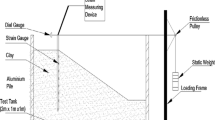Abstract
Estimation of the lateral pile load capacity is the key design procedure for structures where lateral loads are predominant, such as bridges, tall buildings and offshore platforms. In the process of laterally loaded pile design, the p–y curve method is the mainstream method and preferred by designers compared to the elastic continuum or finite element analysis. The traditional p–y curves are derived from some specific field tests and limited data, which do not reflect the overall conditions. In this study, a unified p–y curve based on the stress increment perspective was constructed by introducing Vesic cavity expansion theory and considering the actual stress state of the surrounding soils. The proposed p–y curve combines the contributions of the expansion-induced soil radial stress increment, vertical stress increment and lateral soil resistance caused by deep pile rotation. To validate the proposed method, case examples of lateral pile load tests in various soil conditions were prepared and used to compare the p–y curves from the test results and proposed methods. The p–y curves calculated from the proposed method show reasonable agreement with measured results and give a good prediction in large deformation analysis.












Similar content being viewed by others
References
American Petroleum Institute, API (1987) Recommended practice for planning, designing and constructing fixed offshore platforms, 17th edn. American Petroleum Institute, API-RP2A, Washington DC
American Petroleum Institute, API (2011) Geotechnical and foundation design consideration, ANSI/API Recommended Practice 2 GEO First Edition, April, 2011
Ashour M, Norris G (2000) Modeling lateral soil-pile response based on soil-pile interaction. J Geotech Geoenviron Eng 126(5):420–428
Bishop RF, Hill R, Mott NF (1945) The theory of indentation and hardness. Proc Phys Soc 57:147–159
Clough GW, Duncan JM (1991) Earth pressures. Foundation engineering handbook. Springer, Berlin, pp 223–235
Ensoft, Inc (1999) LPILE Plus 3 for Windows—a program for the analysis of piles and drilled shafts under lateral loads. http://www.ensoft.com
Georgiadis M, Anagnostopoulos C, Saflekou S (1992) Centrifugal testing of laterally loaded piles in sand. Can Geotech J 29(2):208–216
Gibson RE, Anderson WF (1961) In situ measurement of soil properties with the pressure meter. Civil Eng Publ Wks Rev 56:615–618
Huang MS, Yu J, Zhang CR (2015) P-y curve of lateral pile in clay based on strain path approach. Chin J Geotech Eng 37(3):400–409
Kim BT, Kim NK, Lee WJ, Kim YS (2004) Experimental load-transfer curves of laterally loaded piles in Nak-Dong River sand. J Geotech Geoenviron Eng 130(4):447–448
Kondner RL (1963) Hyperbolic stress-strain response: cohesive soils. J Soil Mech Found Div 89(1):115–144
Ma ZT (2006) Study on behavior of pile foundation under lateral loading. J Hohai Univ (Nat Sci) 34(5):546–551 (in Chinese)
Matlock H (1970) Correlation for design of laterally loaded piles in soft clay. OTC l:577–594
Mei GX, Zai JM (2001) Rankine earth pressure model considering deformation. Chin J Rock Mechan Eng 20(6):851–854
Mezazigh S, Levacher D (1998) Laterally loaded piles in sand: slope effect on p–y reaction curves. Can Geotech J 35(3):433–441
Randolph M, Cassidy M, Gourvenec S et al (2005) Challenges of offshore geotechnical engineering. In: Proceedings of the international conference on soil mechanics and geotechnical engineering, vol 16. AA BALKEMA publishers, Boston, no (1), pp 123–176
Reese LC, Cox WR, Koop FD (1974) Analysis of laterally loaded piles in sand. In: Proceedings of the 6th annual offshore technology conference, Houston, Texas, vol 2, no OTC 2080, pp 473–485
Reese LC, Cox WR, Koop FD (1975) Field testing and analysis of laterally loaded piles on stiff clay. Offshore Technology Conference
Salgado R, Randolph MF (2001) Analysis of cavity expansion in sand. Int J Geomech 1(2):175–192
Schmidt B (1966) Earth pressures at rest related to stress history. Can Geotech J 3(4):239–242
Scott RF (1980) Analysis of centrifuge pile tests: Simulation of pile driving. American Petroleum Institute, Washington DC
Shanghai survey and design institute (1997) DBJ 08-61-1997 Standard code for design of excavation engineering. Shanghai, China
Soubra AH (2000) Static and seismic passive earth pressure coefficients on rigid retaining structures. Can Geotech J 37(2):463–478
Sullivan WR (1977) Development and evaluation of a unified method for the analysis of laterally loaded piles in clay. Unpublished Master Thesis, The University of Texas at Austin, May
The Professional Standards Compilation Group of People’s Republic of China (2008) JGJ 94-2008 technical code for building pile foundation. China Architecture and Building Press, Beijing
Vesic AS (1972) Expansion of cavities in infinite soil mass. J Soil Mech Found Div 98(sm3):265–290
Wang HC, Wu DQ, Tian P (1991) A new united method of p–y curves of laterally statically loaded piles in clay. J Hohai Univ 19(1):9–17 (in Chinese)
Yu HS (2013) Cavity expansion methods in geomechanics. Springer Science and Business Media, Dordrecht
Zhang LY, Chen ZC (1992) A new p–y curve construction method in cohesive soils. J Ocean Eng 10(4):50–58
Zhang L, Silva F, Grismala R (2005) Ultimate lateral resistance to piles in cohesionless soils. J Geotech Geoenviron Eng 131(1):78–83
Zhu B, Zhu RY, Luo J et al (2010) Model tests on characteristics of ocean and offshore elevated piles with large lateral deflection. Chin J Geotech Eng 32(4):521–530
Acknowledgements
The majority of the work presented in this article was funded by the National Key Research Projects of China (Grant No. 2016YFC0800201), the National Natural Science Foundation of China (Grant No. 41572273), the Construction Science and Technology Research Project of Jiangsu Province (Grant No. 2014ZD66) and the Fundamental Research Funds for the Central Universities and the Graduate Student Scientific Research Innovation Program of Jiangsu Province (Grant No. KYLX16_0244). These financial supports are gratefully acknowledged.
Author information
Authors and Affiliations
Corresponding authors
Rights and permissions
About this article
Cite this article
Li, H., Tong, L., Liu, S. et al. Construction and verification of a unified p–y curve for laterally loaded piles. Bull Eng Geol Environ 77, 987–997 (2018). https://doi.org/10.1007/s10064-017-1111-7
Received:
Accepted:
Published:
Issue Date:
DOI: https://doi.org/10.1007/s10064-017-1111-7




